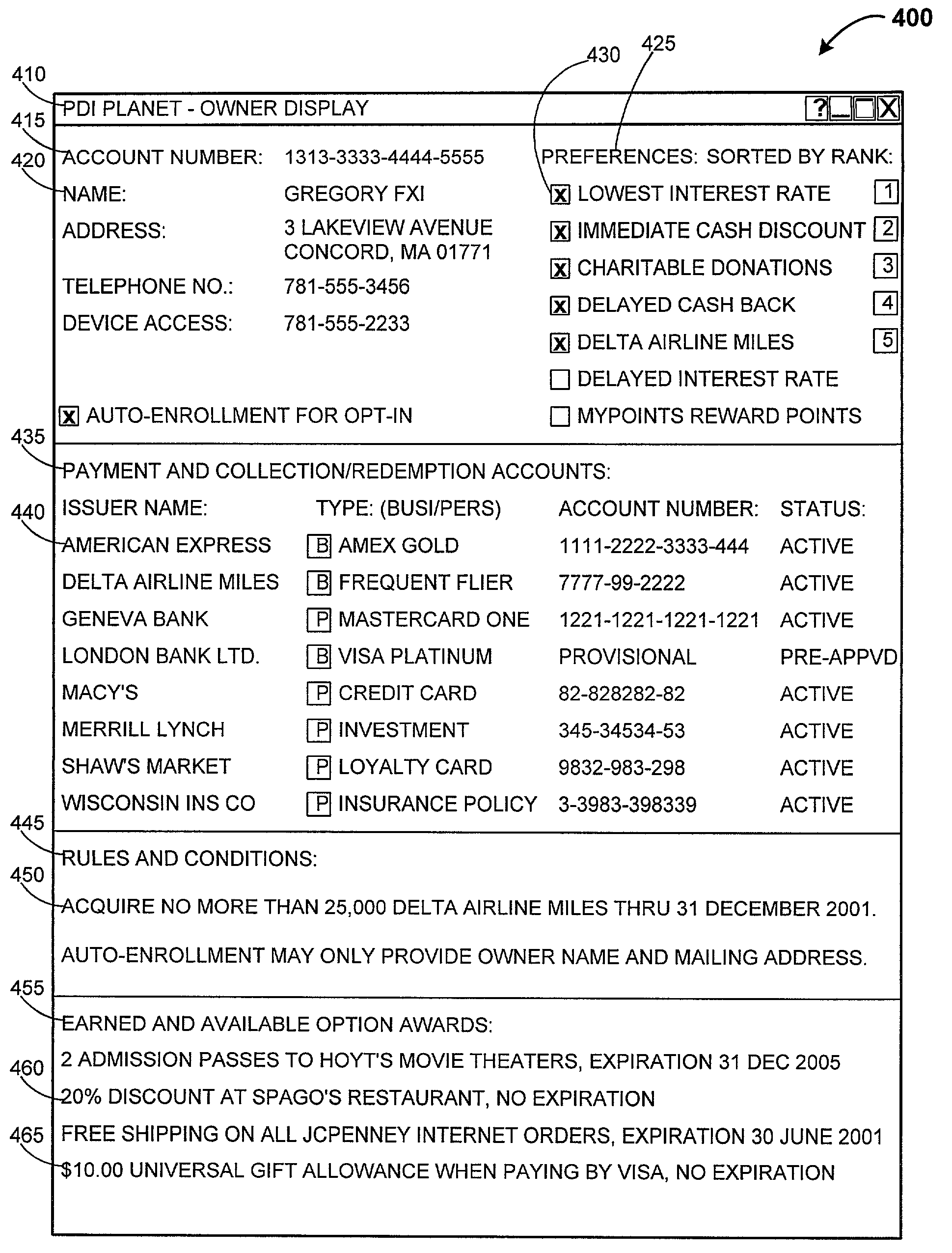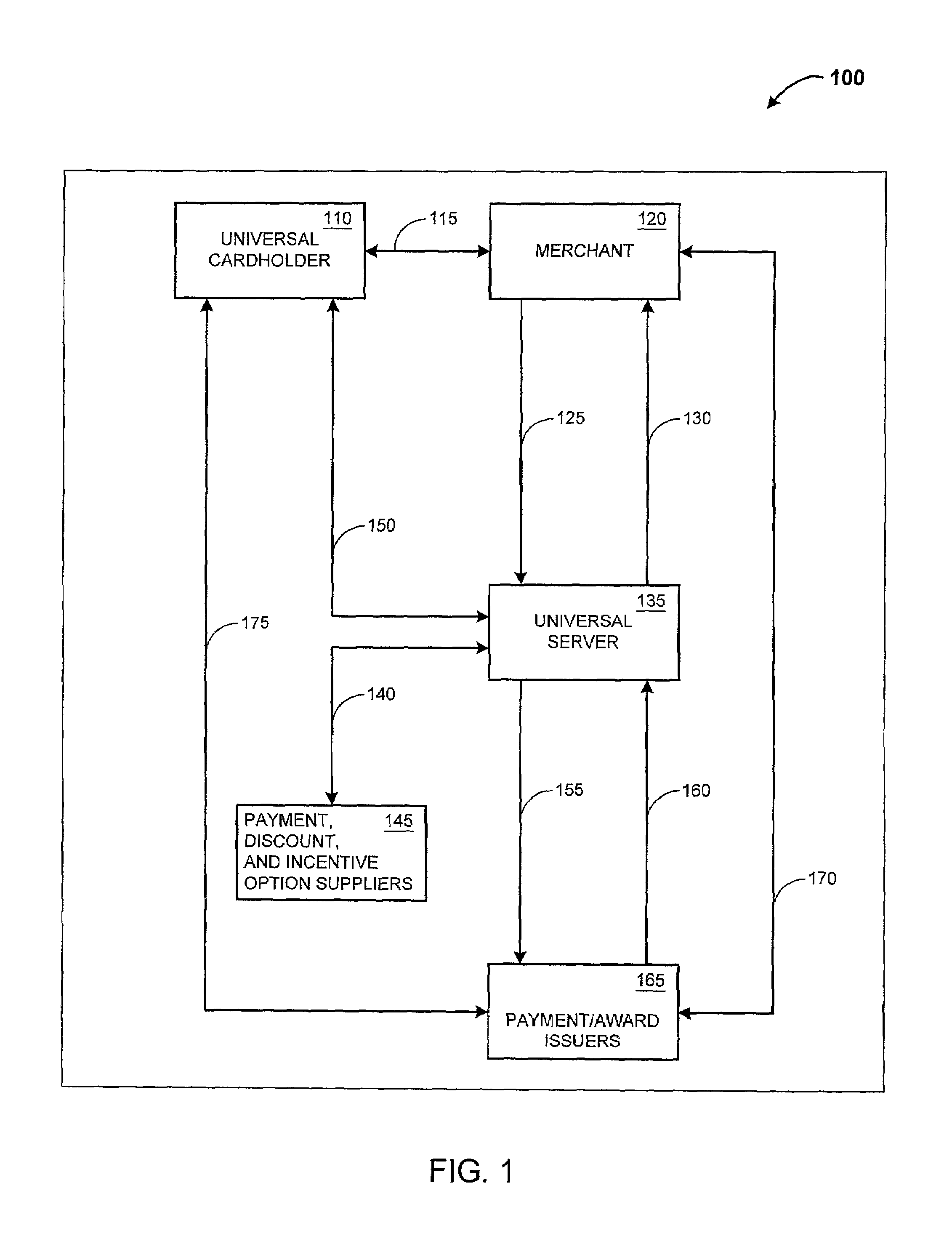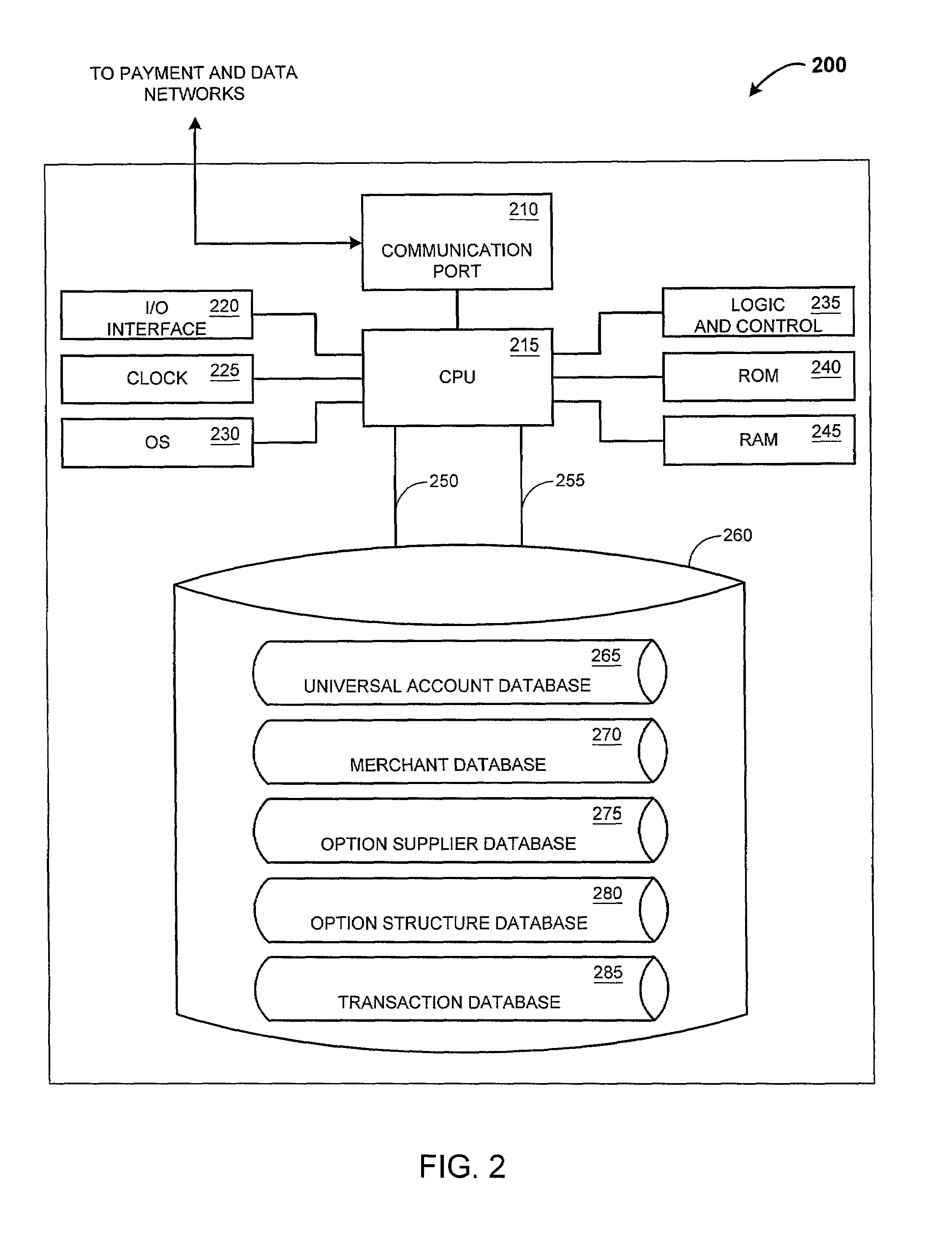The aforementioned
payment and settlement
processing system and incentive award
processing system approach is functionally limited in that: (a) making a
payment is the primary goal while maximising the incentive benefits acquired or utilised is a secondary or ignored undertaking, (b) the selection of incentives and awards is generally based on a static “best award recalled” by the
consumer instead of reference to a dynamic and extensive “best awards available” catalog of benefits with meaningful valuations and rankings, (c) only “in-possession” payment or settlement mechanisms may be used at the time of a transaction (e.g., the need for pre-established and signed credit cards, paper-based discount coupons, downloaded
electronic mail messages with digital-based coupon codes in the
consumer's physical possession), and (d) there is an absence of customised, standardised, and competitive benefit information based on
consumer preferences, equivalent valuations, and the most current overall terms and conditions available from various and multiple incentive and award suppliers aggregated at the time of an action or transaction.
Accordingly, consumers seldom, if ever, receive the maximum or best incentives and awards available when using the prior art due to such reasons as a lack of consumer interest in managing incentives, a lack of easy and effective benefit rankings, and the consequences of a forgetful memory.
As such, the prior art has the
disadvantage that the selection and use of benefits is limited by the amount of time and effort a consumer wants to invest in managing their incentive and award undertakings.
An additional
disadvantage is that consumers have no way of comparing and determining the best benefits when different awards are available.
For example, a consumer may be presented with obtaining either 750 frequent flier airline miles or 425 bonus points and not be able to readily compare the values of such different awards.
People prefer to save money and would consider using incentives to do so, but a comprehensive and convenient method does not exist.
Another
disadvantage is that benefit acquisition and utilisation is dependent on the consumer knowing about benefit opportunities and then remembering to use a particular
credit card or to prepare earned awards, such as converting points into certificates, for benefit redemption in order to receive any utility value.
The consumer is further limited in that they can only make use of conventional incentive award search and discovery methods (e.g., reviewing bulk mail ads, television,
print media, Internet ads, Internet incentive sites such as DealTime and ValPak.com, reading verbose “fine-print” account contracts that explain benefits, word-of-mouth) to piece together a juxtaposition of bewildering information.
A further disadvantage is that a consumer needs to have credit cards, coupons, or other awards “in-hand” for presentation at the time of a transaction.
Furthermore, consumers and incentive award suppliers are significantly limited in their ability to interact with each other during a transaction in ways that would enhance value to both parties.
While consumers may know of and might use conventional incentive award search and discovery mechanisms to review incentive awards, such methods provide virtually no value to the consumer during a transaction since conventional methods only reflect historically published incentive awards and related terms and, more importantly, allow no interaction with the incentive award supplier's current zone of possible agreement, best negotiable alternatives, or dynamic
business objectives as they relate to performance achievement goals and award concession limits at the time of an action or transaction.
Consumers suffer burdens due to this limitation since they cannot easily, conveniently, and effectively filter, evaluate, and avail themselves of the pertinent and extensive opportunities and benefits that incentive award suppliers are willing to provide to them.
While helpful, such
information retrieval systems do not allow the consumer to interact with the incentive award suppliers, either in individual or aggregate transaction forums, to enhance the available incentive awards, to mix-and-match various award combinations, or to create custom incentive awards.
Furthermore, the prior art is limited in that its conventional payment and settlement
processing systems, incentive award processing systems and methods, and incentive award search and discovery mechanisms provide, at best, a simple “got it, don't got it” comparison of benefit features, and as such they do not provide active and dynamic benefit competitions.
Another limitation is that while organisations, such as eCredit.com Incorporated, offer methods to connect businesses to financing partners in order to provide real-time credit to consumers, the financing of a purchase at the time of the purchase is generally based on a financier's acceptance of risk, and such related conditions.
Such methods do not evaluate the consumer's desire for preferred incentives and awards and the commensurate means (e.g., payment accounts, award redemptions) available to acquire such incentives and awards.
Although the purchase is financed, the consumer acquires no additional benefits since there is no knowledge of the consumer's benefit preferences.
Previously proposed enhancements have not allowed consumers to
expose, transmit and have their incentive award preferences and conditions considered at the time of an action or transaction to the payment or incentive award suppliers using the conventional
credit card transaction system, payment and settlement processing system, and incentive award processing system infrastructures such as
credit card stations, point-of-sale workstations, personal computers, or portable computing devices using any processing or connection means such as payment networks or
the Internet.
More particularly, previously proposed enhancements to credit card, payment, settlement, and incentive award systems have not allowed consumers and incentive award suppliers to directly adjust incentive award parameters at the time of an action or transaction that may affect the determination and production of settlement solutions, actions, and related payment or redemption accounts, and such other relevant account items, for delivery to related parties to affect actions and transactions and also user, consumer, merchant, award supplier, and payment and award issuer accounts.
Each of the aforementioned systems and processes require considerable time and effort on the part of the consumer if they seek to obtain benefits.
As such, the need for a consumer to search for incentive awards either manually or using additional systems and processes can be costly, can diminish the intended value of the incentive awards requiring such additional time, effort, systems and processes, and can limit the intended benefits to consumers.
Accordingly, the shortcomings associated with the prior art have heretofore not been adequately addressed.
However, no proposals to date have enabled award suppliers and consumers to interact with related actions and transactions, in either a singular or aggregate transaction format, in conjunction with a plurality of incentive awards (i.e., benefit options and condition structures) at the time of an action or transaction in order to affect the supplied and acquired incentive awards, the determination of benefits and consequent selection of actions, payment or redemption accounts and relevant account items, transactions, and also user, consumer, merchant, award supplier, and payment and award issuer accounts.
The limitations of such manual selection and use of a “non-benefit-qualified” payment account identifier does not furnish the buyer with the best incentives and awards available at the time of purchase.
Unfortunately, the consumer's laborious endeavours do not end there since they must also compare disparate values among incentive awards, such as determining the equivalence and assessed value of one Aria reward point versus two
Delta SkyMiles frequent flier miles.
The consumer also is burdened to comply with other “fine print” terms and conditions such as determining qualifying purchases and initiating incentive award claims prior to expiration dates.
Presently, the consumer may not learn or be told about better settlement or exchange actions to perform that will introduce benefits that reduce the price of items or that acquire beneficial incentives and awards.
For example, only rarely does a sales clerk produce a discount coupon for a customer when such customer is unaware of recently bulk-mailed
sales promotion materials or if the customer did not remember to take their member loyalty card or coupons to the marketplace.
A traveler is at a significant disadvantage since they may be in an unfamiliar area and need to purchase goods or services yet have no
exposure to the local newspaper or other information sources to become aware of discount coupons or other vicinity benefits.
From the buyer's perspective, the conventional credit card transaction systems, payment and settlement processing systems, and incentive award processing systems are not capable of providing the buyer the abilities to easily, conveniently, and effectively identify, compare, determine, select, acquire, and utilise preferred and superior incentive awards on a strategic, ad hoc, or post hoc basis and then guide actions and deliver the appropriate payment or redemption account identifier, or multiple payment or redemption account identifiers, and such other relevant account items to the related payment and award issuers in order to acquire selected incentive awards for the buyer and, in addition, to settle the transaction with the merchant.
For example, while the previously mentioned PNB MyPoints awards that accrue in a buyer's incentive collection account maintained by PNB may be utilised within any PNB sponsored redemption environment, there is limited ability to compare and redeem such points outside the boundaries of the MyPoints program or affiliated redemption networks and venues.
From the award supplier's perspective, the conventional credit card transaction systems, payment and settlement processing systems, and incentive award processing systems
restrict the award supplier's ability to introduce enhanced or competitive incentive award assertions at the time of an action or payment or settlement determination, such as during a purchase transaction, in order to persuade consumers to acquire their particular incentive awards and thus use the corresponding payment or redemption account.
Incentive award suppliers generally rely upon passive marketing campaigns to solicit account usage by offering awards that may be ineffective for many reasons including such causes as: (a) the consumer does not become aware of incentive awards or otherwise understand the award supplier's collateral material (e.g., non-subscription to targeted media channels, language barriers), (b) consumers are not informed of awards due to discriminatory practices, (c) the consumer does not physically carry all of their payment or redemption account identifiers with them (e.g., credit cards, debit cards, smart cards, loyalty cards, discount coupons) and thus, may not have the appropriate account identifier card in their possession at the time of a purchase, (d) the consumer may have access to their payment or redemption accounts by electronic methods and thus not require a physical card (e.g., the telematic use of cellular telephones to authorise payment at vending machines), but the telematic linkage with and use of a payment or redemption account is statically configured and does not offer dynamic payment or redemption account allocations based on benefits and incentive awards, (e) the consumer becomes aware of the incentive awards but forgets to use the appropriate payment or redemption account identifier at the time of a purchase, or (f) the consumer is a creature of
habit and presents the same payment account identifier (e.g., Fleet Visa credit card) for all purchases ignoring available benefits and incentive awards based on reasons such as not wanting to spend time and effort searching for incentive awards or remembering the diverse awards, terms, conditions, and usage requirements.
While such conventional methods promote incentive awards to the consumer, the awareness level only extends to the limited television or mail coverage area, and then, unfortunately, such promotions usually arrive either in advance of, or too late after, a transaction's critical decision intervals.
Such conventional incentive award marketing methods ultimately may not reach, or the awards may not be used by, the consumer regardless of how well the incentive awards match a consumer's award preferences or even if the awards provide the best available benefits to the consumer.
The prior art's focus on“mindshare” also inherently limits the flexibility of incentive award suppliers with respect to their incentive award
metrics.
Overall, the prior art of conventional credit card transaction systems, payment and settlement processing systems, and incentive award processing systems does not provide either the consumers with the ability to coordinate their actions and ascertain and utilise the most advantageous benefits and incentive awards and then exchange or deliver related payment or redemption accounts, or the incentive award suppliers with the ability to compete for customer actions and business at the time of an action or transaction, such as planning for or engaging in a purchase transaction.
While there may be a limited ability for sales clerks and cashiers to manually enter discounts or alternative awards using conventional payment and settlement processing systems and incentive award processing systems at the time of a transaction, such ability is grievously lacking additional functionality since there is no incentive award supplier competition introduced into said transaction environment from outside the merchant's and consumer's immediate boundaries.
This system does not provide the consumer with the ability to institute rivalry among and between incentive award suppliers at the time of an action or transaction and thus have the incentive award suppliers compete to provide additional points for the same dollars.
Consequently, the “points” program offers static incentive awards, is benefit supplier driven, and thus is not capable of responding to any consumer preferences or competing incentive awards available from other benefit suppliers at the time of an action or transaction.
It is well known that competition is a precursor to the delivery of better products, and the consumer is at a disadvantage if active benefit competition is not introduced into incentive award transactions at various and significant transaction decision opportunities.
 Login to View More
Login to View More  Login to View More
Login to View More 


